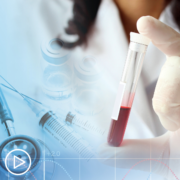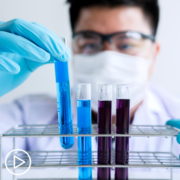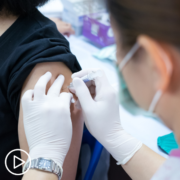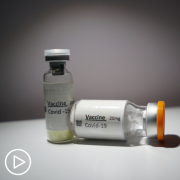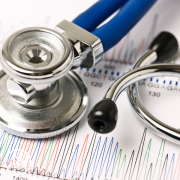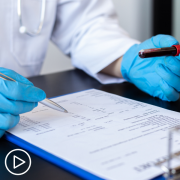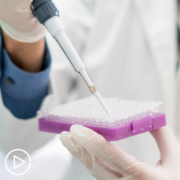What Key Tests Do You Need Before Choosing an AML Treatment? from Patient Empowerment Network on Vimeo.
How do test results influence treatment choices for AML? Dr. Eunice Wang shares information about essential testing and explains how results aid in determining the best personalized treatment option for each patient.
Dr. Eunice Wang is the Chief of the Leukemia Service and Professor of Oncology at the Roswell Park Comprehensive Cancer Center in Buffalo, New York. Learn more about Dr. Wang, here.
See More From INSIST! AML
Related Resources:
Transcript:
Katherine:
What is the role of testing when deciding on treatment for AML?
Dr. Wang:
Testing is essential in us selecting and determining the best personalized treatment option for each individual patient. As you know, AML is an aggressive hematologic malignancy and can be devastating, both in its life-threatening nature and in its rapidity and the need for a rapid diagnosis. Testing, including both pathology results as well as protein marker testing, and, importantly in this day and age, DNA and RNA testing is essential because we have numerous different treatment options that could be available to the patient if their particular disease biology matches with the targeted therapies that we have.
So, as you may or may not know, since 2017, we’ve had eight or nine different therapies approved for AML, and this is a bonanza of options, some of which are only for specific biological subsets, and some even for specific patients, such as those above the age of 75. So, doing that testing, particularly that genetic testing, is important both in establishing the diagnosis and determining whether there is less toxic, more targeted, personalized treatment approaches, some of which involve low-dose chemo or even pills available to the individual patient.
Katherine:
You’ve answered this, in part, but which tests are essential following an AML diagnosis?
Dr. Wang:
I think all of them are essential, but in this day and age, for the selection of targeted therapy, it really is the mutational testing, which is looking at the RNA of the tumor cells and determining whether that has been altered in allowing the cells to express abnormal proteins. For standard chemotherapy, we also use DNA testing, which is looking at the different chromosomes and seeing whether there’s breakages or what we call translocations, pieces of chromosomes that have been swapped. That DNA chromosome information can give us some insight into prognosis and therapy response.
So, nowadays, it’s not just determining that you have acute leukemia, but looking at the specific DNA and RNA changes, and I have to say that this is a disease that we’re really not seeing any RNA or mutational changes occurring in more than 20 percent or 30 percent of patients. So all of the mutations that we see that could be impactful really don’t occur in more than 20 percent or 30 percent, and could only occur in five or one percent.
So, really, personalizing an individual patient’s disease, both for the disease biology as well as the person that’s getting the chemotherapy or the diagnosis, is really, really important.
Katherine:
Yeah. Let’s define a few terms that are often confusing for patients. What are biomarkers?
Dr. Wang:
Biomarkers are either proteins or expression levels on the cancer cells that can serve to tell us information about the biology of the disease. Okay, so, for example, if you have evidence of residual tumor proteins in your blood, that could be a marker, for example, of minimal residual disease, okay? And, that can tell you maybe one in a million cells have that biomarker, and then you can tell that those one-in-a-million cells are leukemia cells.
So, they’re any marker that we’re using that’s specific for the tumor that can help us in predicting or finding or locating or determining if a tumor would respond to a certain therapy.
Katherine:
What is biomarker testing?
Dr. Wang:
Biomarker testing can be done in many ways. For example, biomarker testing is drawing a sample from the patient and evaluating a marker that we think is going to predict for the disease type.
So, for example, in some cancers, we don’t want to biopsy the lung mass or the tumor mass every single time to see whether it’s shrinking, or getting smaller, or responding. So, in those patients, sometimes we’ll draw a blood sample, and we’ll look for a surrogate marker – some protein that’s expressed in the blood or some DNA or RNA in the blood that is a surrogate or a marker of the tumor so you don’t have to directly biopsy it.
In acute myeloid leukemia, we are looking for – like I said – particular cells in the blood that have particular proteins, and we measure those rather than going ahead and doing that bone marrow biopsy or biopsying those tumors. So, generally, in leukemia, it involves drawing blood samples – that’s the most common; it is a bloodborne disease.
Sometimes, we actually have to go into the bone marrow and do a bone marrow sample, but those biomarkers, as I said, can really improve our ability to detect very, very low levels of disease. So, for example, using a conventional bone marrow biopsy, we can only really detect 1 out of 200 cancer cells by normal – just by visual looking at, but by measuring biomarkers and mutations and other abnormal proteins, we can improve that to 1 in 100,000 cells.
So, really, these biomarkers are very sensitive and important because we want to detect the disease at a point where it’s very, very low. We don’t want to wait until the disease gets very advanced, in which case we think our therapies are less effective.
Katherine:
What is a genetic mutation?
Dr. Wang:
A genetic mutation is a mutation that occurs in the RNA of a cancer cell. That RNA dam – RNA aberration or abnormality does lead to different RNA – what we call transcript levels that lead to abnormal proteins.
Those proteins function in the cells to make a cell a cancer cell, okay? So, all cancer cells start out as normal cells, and as they acquire a mutation, they become a little less normal, and they start acquiring multiple mutations, and some of these mutations occur without DNA changes, some of them occur with DNA changes. And as these abnormalities occur, the cell gets more and more dysfunctional, and eventually, it starts becoming almost evil-ish.
It starts acquiring behaviors that are not normal, and then it starts to grow out of control, and that unchecked growth really is the end result of potentially many mutations occurring over time to drive that cell into becoming a cancer cell, and we call that process transformation, transforming from a normal, healthy-looking cell into almost a monstrous, cancer-like cell.
Katherine:
How do biomarkers affect AML treatment choices?
Dr. Wang:
So, those biomarkers, as I talked about, those mutations can determine what type of therapy patients can have. For example, up to 25 percent or 37 percent of newly diagnosed AML patients will have leukemia cells that carry the biomarker or the mutation in a gene called FLT3, or “flit.”
Those FLT3 cells can be inhibited by specific targeted therapies, including a drug called gilteritinib (Xospata), which is a pill which blocks mutant FLT3 expressed by AML cells. So, we’ve demonstrated, actually, in a randomized clinical trial that patients who have relapsed or recurrent AML who carry cells that have that biomarker – that FLT3 mutation – will actually do better if they take a daily pill – a FLT3 inhibitor – every single day for treatment of their aggressive acute myeloid leukemia than if we gave them low- or even high-dose chemotherapy in the hospital for four to six weeks.
So, that’s the power of those targeted therapies. Because the biomarker is telling you that there’s a sensitivity of that cancer cell to a specific blockage of that pathway, that can really dramatically change the course.
That is where the importance and the power of those biomarkers really goes into play. In the past, patients who had acute myeloid leukemia with FLT3 mutations did poorly with chemotherapy and had disease that came back even after multiple rounds of that intensive chemotherapy. The fact that we can give a pill and people could do better or even go to a bone marrow transplant off treatment with the pill is pretty remarkable.
